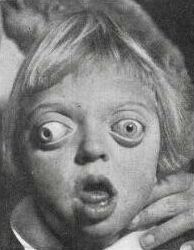Medicine:Facies (medical)
From HandWiki
Short description: Distinctive facial appearance associated with a medical condition
| Facies | |
|---|---|
 | |
| Facial abnormalities associated with Crouzon syndrome | |
| Specialty | Medical genetics |
In medical contexts, a facies is a distinctive facial expression or appearance associated with a specific medical condition.[1] The term comes from Latin for "face".[2] As a fifth declension noun,[3] facies can be both singular and plural.
Types
Examples include:
- Hippocratic facies – eyes are sunken, temples collapsed, nose is pinched with crusts on the lips, and the forehead is clammy
- Moon face (also known as "Cushingoid facies") – Cushing's syndrome
- Elfin facies – Williams syndrome
- Potter facies – oligohydramnios
- Mask like facies – parkinsonism
- Leonine facies – lepromatous leprosy or craniometaphyseal dysplasia[4]
- Mitral facies – mitral stenosis
- Amiodarone facies (deep blue discoloration around malar area and nose)
- Acromegalic facies – acromegaly
- Flat facies – Down syndrome
- Marfanoid facies – Marfan's syndrome
- Snarling facies – myasthenia gravis
- Myotonic facies – myotonic dystrophy
- Torpid facies – myxoedema
- Mouse facies – chronic kidney failure
- Plethoric facies – Cushing's syndrome and polycythemia vera
- Bird facies – Pierre Robin sequence
- Ashen grey facies – myocardial infarction
- Gargoyle facies – Hurler's syndrome
- Monkey facies – marasmus
- Hatchet facies – myotonia atrophica
- Gorilla-like face – acromegaly
- Bovine facies (or cow face) – craniofacial dysostosis or crouzon syndrome
- Marshall halls facies – hydrocephalus
- Frog face – intranasal disease
- Coarse facies – many inborn errors of metabolism
- Adenoid facies – developmental facial traits caused by adenoid hypertrophy, nasal airway obstruction and mouthbreathing; really a form of long face syndrome.
- Lion-like facies – involvement of craniofacial bones in Paget disease of Bone
- Chipmunk facies – beta thalassemia
- Treacher Collins syndrome – deformities of the ears, eyes, cheekbones, and chin
Other disorders associated with syndromic facies
- Pitt–Hopkins syndrome
- Beta thalassemia is associated with distinctive facial features due to ineffective erythropoiesis. The ineffective erythropoiesis causes marrow hyperplasia or expansion and bony changes, including the bones of the face; this causes craniofacial protrusions.[5]
- Mowat–Wilson syndrome
See also
- Body habitus
References
- ↑ "Definition of FACIES" (in en). https://www.merriam-webster.com/dictionary/facies.
- ↑ "Dorlands Medical Dictionary:facies". http://www.mercksource.com/pp/us/cns/cns_hl_dorlands_split.jsp?pg=/ppdocs/us/common/dorlands/dorland/three/000038177.htm.
- ↑ "NOUNS OF THE FOURTH DECLENSION". http://webpages.ursinus.edu/classics/latin/nouns_fourthfifthdecl_forms.htm.
- ↑ "Craniometaphyseal Dysplasia - NORD (National Organization for Rare Disorders)". https://rarediseases.org/rare-diseases/craniometaphyseal-dysplasia/.
- ↑ Taher, Ali T.; Musallam, Khaled M.; Cappellini, M. Domenica (25 February 2021). "β-Thalassemias". New England Journal of Medicine 384 (8): 727–743. doi:10.1056/NEJMra2021838.
- ↑ "Snijders Blok-Campeau syndrome: MedlinePlus Genetics" (in en). https://medlineplus.gov/genetics/condition/snijders-blok-campeau-syndrome/.
- ↑ "Snijders Blok-Campeau syndrome (Concept Id: C4748701) - MedGen - NCBI" (in en). https://www.ncbi.nlm.nih.gov/medgen/1648495.
External links
| Classification |
|---|
- Face in Clinical Medicine
- wikt:facies
 |

